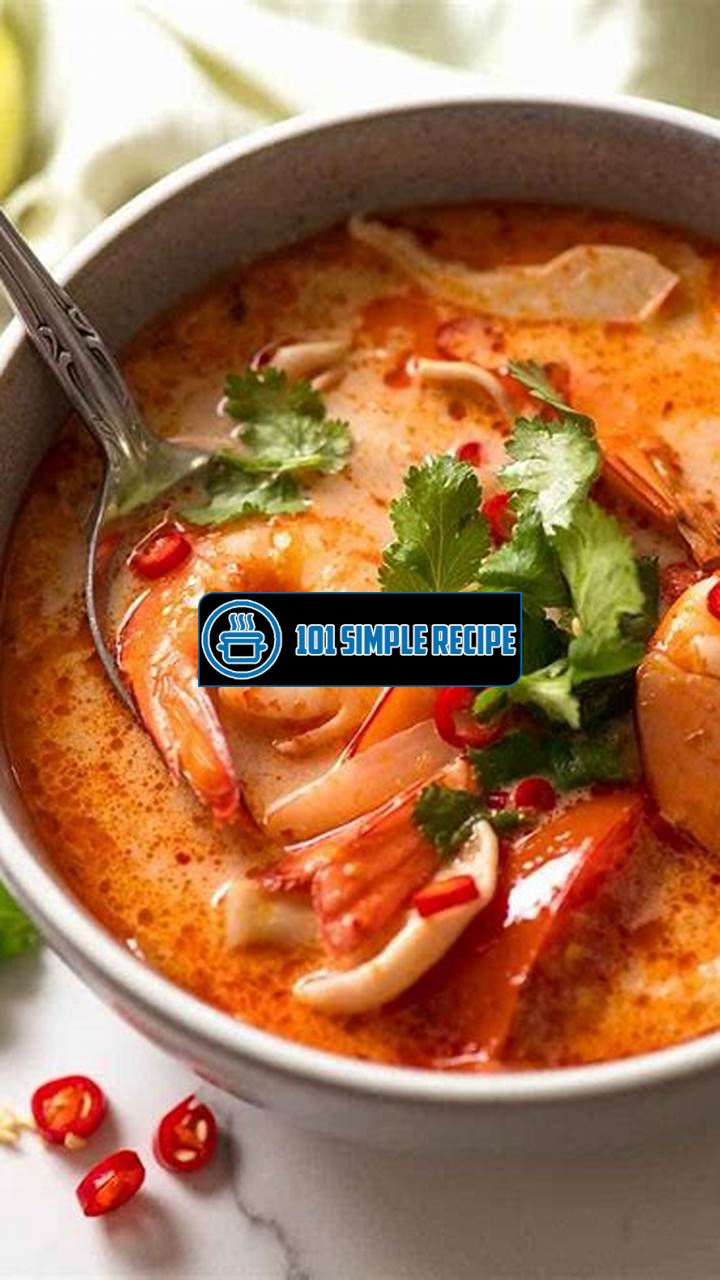If you’re a fan of Thai cuisine, you’ve probably indulged in the deliciousness of Tom Yum soup before. The tangy and aromatic flavors of this traditional Thai dish are enough to make anyone’s taste buds dance with joy. But have you ever wondered how you can recreate that authentic taste at home? Look no further, because in this article, we will show you how to make authentic Thai Tom Yum soup paste from scratch. ✨

History and Origins
Discover the fascinating history and cultural significance of Thai tom yum soup paste.
Ancient Roots of Thai Cuisine
The origins of Thai cuisine can be traced back thousands of years, with influences from various cultures and regions. Thai cooking has evolved over time, incorporating elements from neighboring countries such as China, India, and Malaysia. These diverse influences have contributed to the unique flavors and ingredients found in Thai dishes, including tom yum soup paste.
In ancient times, Thai cuisine revolved around simple ingredients like rice, noodles, vegetables, and herbs. The use of local spices and herbs played a vital role in enhancing the flavors of Thai dishes. These herbs were often sourced from the rich biodiversity of the Thai landscape, which includes fragrant lemongrass, kaffir lime leaves, galangal, and Thai chili peppers.
Thai people have a deep appreciation for the balance of flavors in their cuisine, combining elements of sweetness, saltiness, spiciness, and sourness. This balance is achieved through the skillful use of traditional ingredients and cooking techniques.
One of the most iconic and flavorful dishes in Thai cuisine is the tom yum soup. This hot and sour soup is known for its vibrant aroma and the complex interplay of flavors. At the heart of this soup is the authentic Thai tom yum soup paste, which serves as the foundation for its distinctive taste.
Evolution of Tom Yum Soup
The evolution of tom yum soup is a fascinating journey through Thai culinary history. It is believed that the soup was originally created by the Lao people, an ethnic group residing in what is now modern-day Laos. Over time, the recipe for tom yum soup made its way to Thailand.
Initially, the soup was a simple concoction of fresh herbs and spices boiled in water. It was often paired with grilled or steamed fish or seafood, creating a delightful combination of flavors. As Thai cuisine developed and gained international recognition, so did the popularity of tom yum soup. Chefs began experimenting with different variations and techniques, resulting in the creation of the beloved tom yum soup we know today.
Note: Authentic Thai tom yum soup paste is a key ingredient in preparing this iconic soup. Its unique blend of herbs and spices adds depth and complexity to the dish. By making this paste at home, you can experience the true flavors of authentic Thai cuisine.
In conclusion, the history and origins of Thai tom yum soup paste reveal the rich cultural heritage and culinary traditions of Thailand. From its ancient roots in Thai cuisine to its evolution into a beloved national dish, tom yum soup paste remains an essential component of Thai cooking. The influence of Thai ingredients, such as lemongrass, kaffir lime leaves, and Thai chili peppers, infuses the soup with its distinct flavors. By understanding the history and origins of tom yum soup paste, you can appreciate the depth and complexity of this iconic Thai dish. So, why not embark on a culinary adventure and try making authentic Thai tom yum soup paste at home?
Essential Ingredients
When it comes to making authentic Thai tom yum soup paste at home, the key lies in the selection of ingredients. Each component contributes to the overall flavor profile, resulting in a harmonious blend of savory, spicy, and citrusy notes that make this dish truly unforgettable. Let’s explore the essential ingredients that give this paste its distinctive taste.
Lemongrass: The Fragrant Base
The first ingredient that forms the fragrant base of Thai tom yum soup paste is lemongrass. Known for its citrusy aroma and refreshing taste, lemongrass adds a zesty kick to the paste. To incorporate lemongrass into your homemade paste, begin by removing the tough outer layers and then finely chop the tender inner stalks. By doing so, you release the flavorful oils and ensure that the lemongrass infuses the soup with its unmistakable scent and taste.
Pro tip: Lemongrass can be quite fibrous, so make sure to slice it thinly to avoid any unpleasant chewy textures in your soup.
Galangal: The Spicy Kick
A crucial ingredient that provides the fiery and spicy kick to Thai tom yum soup paste is galangal. ️ This root, resembling ginger, has a distinctive flavor that is both peppery and slightly sweet, creating a perfect balance of heat and depth. To use galangal in your paste, peel the tough outer layer and then finely mince or grate the tender flesh. This allows the galangal to release its bold flavors during the cooking process, infusing the soup with its intense spiciness.
Pro tip: If you can’t find fresh galangal, you can use dried galangal powder as a substitute. However, fresh galangal provides a more vibrant taste that truly elevates the soup.
Kaffir Lime Leaves: The Citrus Zing
The final ingredient that adds a burst of citrusy zing to Thai tom yum soup paste is kaffir lime leaves. These fragrant leaves have a distinct aroma and flavor that complements the other ingredients perfectly. To incorporate kaffir lime leaves into your homemade paste, remove the tough central vein and finely shred the leaves. This allows the essence of the leaves to infuse the soup, providing that refreshing citrus undertone.
Pro tip: If fresh kaffir lime leaves are not available, you can use dried ones as a substitute. However, fresh leaves offer a more vibrant and aromatic flavor.
In conclusion, by carefully selecting and preparing these essential ingredients, you can create an authentic Thai tom yum soup paste right in your own kitchen. Lemongrass, galangal, and kaffir lime leaves each contribute their unique flavors to the paste, resulting in a soup that is both comforting and exciting to the taste buds. So, let your culinary journey begin and experience the magic of homemade Thai tom yum soup paste!
If you’re looking for other delicious recipes, try making homemade peanut butter cups.
Preparation Techniques
Learn the step-by-step process of making homemade Thai tom yum soup paste.
Ingredient Selection and Quality
When making authentic Thai tom yum soup paste at home, the selection and quality of ingredients play a crucial role in achieving the true flavors. To create an exceptional paste, it is essential to use fresh and high-quality ingredients.
Note: Using fresh ingredients ensures that the flavors are vibrant and aromatic.
Start by selecting the best lemongrass, galangal, and kaffir lime leaves available in your local market or grocery store. Look for lemongrass stalks that are firm and green. The galangal should have a strong aroma and be free from any soft spots or blemishes. Additionally, choose fresh kaffir lime leaves that are bright green and exhibit a distinct citrusy fragrance.
Note: These ingredients are the backbone of the tom yum paste and contribute to its unique Thai flavors.
Next, make sure to source fresh Thai chili peppers. The spiciness of the soup paste depends on the type of chili pepper used. Thai chili peppers are known for their fiery heat, so if you prefer a milder version, you can opt for milder chili peppers.
Note: Adjust the amount of chili pepper according to your spice tolerance.
For the garlic cloves, choose firm and plump ones. Fresh garlic imparts a distinct flavor to the paste, so it is worth investing in good-quality garlic. Similarly, select shallots that are firm and have a papery skin, as they add a delicate sweetness to the paste.
Note: Fresh garlic and shallots elevate the aroma and flavor profile of the tom yum soup paste.
Proper Chopping and Blending Methods
The way you chop and blend the ingredients is crucial for achieving the perfect texture and consistency of the tom yum soup paste.
Note: Proper chopping and blending ensure that the flavors are well incorporated and evenly distributed.
Start by washing and cleaning the lemongrass stalks. Remove the outer layers and chop the tender part into small pieces to make it easier to blend. Galangal should be peeled and sliced thinly for optimum blending results.
Note: Chopping the lemongrass and galangal into smaller pieces aids in achieving a smooth paste.
Afterwards, it’s time to peel and chop the garlic cloves and shallots. It is recommended to finely chop the garlic and shallots before blending to avoid any rough texture in the paste.
Note: Finely chopped garlic and shallots ensure a smooth and consistent paste texture.
Now, it’s time to blend all the ingredients together. Using a powerful blender or food processor, blend the lemongrass, galangal, garlic, shallots, Thai chili peppers, and kaffir lime leaves until they form a smooth and well-combined paste.
Note: Blending the ingredients thoroughly ensures a paste that is easy to incorporate into your tom yum soup.
Best Practices for Balancing Flavors
Creating authentic Thai tom yum soup paste requires a delicate balance of flavors. To achieve the perfect blend, follow these best practices:
- Balance the spicy, sour, and sweet flavors: Adjust the amount of Thai chili peppers, lime juice, and palm sugar according to your desired level of spiciness, sourness, and sweetness. Taste the paste as you add each ingredient, gradually building the desired flavor profile.
- Consider the umami factor: Umami is the savory taste that adds depth and richness to the paste. To enhance umami, you can add a small amount of fish sauce or soy sauce. This will give the paste an extra layer of flavor.
- Experiment with additional ingredients: While the core ingredients are essential for an authentic tom yum paste, you can personalize the flavors by adding other ingredients such as coriander roots or shrimp paste. These additions can add complexity and depth to the final paste.
Note: Achieving a well-balanced flavor profile is the key to an exceptional tom yum soup paste.
By following these preparation techniques, you can create an authentic Thai tom yum soup paste at home that captures the true essence of this iconic dish. Enjoy the vibrant flavors of Thailand in the comfort of your own kitchen!
Check out this flavorful recipe for authentic Thai curry paste to elevate your dishes.
Variations and Adaptations
When it comes to Thai tom yum soup paste, there are numerous variations and adaptations to suit different tastes and regional preferences. Some of the most popular versions include:
- Classic Tom Yum Soup Paste: This is the traditional recipe that forms the base for all other variations. It combines the flavors of lemongrass, kaffir lime leaves, galangal, shallots, and chili.
- Tom Yum Nam Sai: This version is known for its clear broth and is typically made with a blend of fresh herbs like lemongrass, lime leaves, and galangal. It has a lighter and less spicy flavor compared to other variations.
- Tom Yum Talay: This seafood-based variation includes ingredients like shrimp, squid, mussels, and mushrooms. It offers a delightful combination of flavors from the ocean and the aromatic herbs.
- Tom Yum Gun Seekrong: This adaptation uses chicken as the main protein and incorporates additional spices like cloves and star anise to enhance the flavor profile.
- Tom Yum Hed: For all the mushroom lovers out there, this variation swaps out the seafood or meat and uses a variety of mushrooms like oyster, shiitake, and straw mushrooms.
Each version of tom yum soup paste has its own unique characteristics and flavors, allowing you to choose the one that best suits your taste buds. The regional variations also play a role in influencing the ingredients used and the intensity of spiciness.
Vegetarian and Vegan Options
If you follow a vegetarian or vegan diet, you can still enjoy the delicious flavors of Thai tom yum soup paste. Here are some options for you to try:
- Swap out animal-based ingredients: Simply omit the shrimp or any other meat used in the recipe and focus on the aromatic herbs and spices. You can enhance the flavor with tofu, tempeh, or extra vegetables.
- Use vegetable stock: Instead of using meat or seafood stock as the base of your soup, opt for vegetable stock. This will give you a rich and flavorful broth.
- Explore plant-based alternatives: There are several vegan-friendly tom yum soup pastes available in stores or online. Look for products that specifically mention being suitable for vegetarians or vegans.
With these adaptations, you can enjoy a vegetarian or vegan version of tom yum soup paste without compromising on taste or flavor.
Seafood and Prawn-Based Varieties
If you’re a seafood lover, then the seafood and prawn-based variations of tom yum soup paste will surely satisfy your cravings. Here are some popular choices:
- Tom Yum Goong: This classic version uses shrimp as the main ingredient and is loved for its robust flavor.
- Tom Yum Talay: As mentioned earlier, this variation combines an assortment of seafood like squid, mussels, and mushrooms to create a delightful medley of flavors.
- Tom Yum Haeng Goong: This unique variation involves using dried prawns, which adds a deeper umami flavor to the soup paste.
Whether you prefer the sweetness of prawns or the assortment of flavors from different seafood, there is a tom yum soup paste variation to suit your palate.
Spicy and Mild Adjustments
The level of spiciness in tom yum soup paste can be adjusted according to your preference. If you love the heat, you can add more chili or chili paste. On the other hand, if you prefer a milder version, you can reduce or omit the chili altogether.
Additionally, you can balance the spiciness with other flavors by adding more lime juice for acidity, sugar for sweetness, or fish sauce for saltiness.
Remember, tom yum soup paste is all about finding the perfect balance of flavors that suits your taste buds. So don’t be afraid to experiment and make adjustments to create your own signature version of this popular Thai delicacy.
Health Benefits and Nutrition
Uncover the health benefits of including Thai tom yum soup paste in your diet. Thai tom yum soup paste is not only delicious but also packed with a range of health benefits. With its unique blend of herbs and spices, this paste offers a flavorful and nutritious option for those looking to add some variety to their meals.
Immune-Boosting Properties
One of the key health benefits of Thai tom yum soup paste is its immune-boosting properties. The combination of ingredients such as lemongrass, ginger, and garlic helps to strengthen the immune system, making it more resistant to illnesses and infections. These ingredients are known for their antibacterial and antiviral properties, which can help to keep you healthy and protected.
Lemongrass is rich in antioxidants that can help fight off free radicals and strengthen the immune system. It also has antimicrobial properties that can help prevent and fight infections.
Ginger contains powerful compounds called gingerols, which have been shown to have immune-boosting effects. Ginger also has anti-inflammatory properties and can help to relieve symptoms of colds and flu.
Garlic is well-known for its immune-boosting properties. It contains sulfur compounds that can stimulate the production of white blood cells, which are essential for fighting off infections.
Anti-inflammatory Effects
In addition to its immune-boosting properties, Thai tom yum soup paste also has anti-inflammatory effects. The combination of ingredients such as galangal, lime leaves, and chili offers a powerful anti-inflammatory punch. Inflammation is a natural response of the body to injury or infection, but chronic inflammation can be harmful and contribute to various health problems.
Galangal, also known as Thai ginger, has been used for centuries in traditional medicine for its potent anti-inflammatory properties. It can help reduce inflammation in the body and alleviate symptoms of inflammatory conditions such as arthritis.
Lime leaves contain compounds that have been shown to have anti-inflammatory effects. They can help reduce inflammation and provide relief from conditions such as joint pain and muscle soreness.
Chili peppers contain capsaicin, a compound that gives them their spicy taste. Capsaicin has been shown to have anti-inflammatory effects and can help reduce pain and inflammation in the body.
Nutritional Profile of Key Ingredients
The nutritional profile of Thai tom yum soup paste is also worth mentioning. It is low in calories and fat, making it a healthy choice for those looking to maintain a balanced diet. The key ingredients in the paste provide a range of essential nutrients.
Lemongrass is a good source of vitamins A and C, iron, and potassium. It is also low in calories and contains no fat or cholesterol.
Ginger is rich in antioxidants and contains vitamins B6 and C, magnesium, and potassium. It is low in calories and fat, making it a nutritious addition to your diet.
Galangal is low in calories and fat and contains essential nutrients such as iron, vitamin C, and antioxidants.
Lime leaves are rich in vitamins A and C, calcium, and antioxidants. They are also low in calories and contain no fat.
Chili peppers are a good source of vitamins A and C and contain capsaicin, which has been shown to have various health benefits. They are low in calories and fat.
By including Thai tom yum soup paste in your diet, you can enjoy its immune-boosting properties, anti-inflammatory effects, and a range of essential nutrients. So why not try making your own authentic Thai tom yum soup paste at home today?
Learn how to make homemade hoisin sauce from scratch.
Frequently Asked Questions
Here are some common questions about making real Thai Tom Yum soup paste:
| No. | Questions | Answers |
|---|---|---|
| 1. | What ingredients are needed for an authentic Thai Tom Yum soup paste? | The main ingredients for a real Thai Tom Yum soup paste include lemongrass, galangal, kaffir lime leaves, Thai chili peppers, coriander roots, shallots, garlic, and shrimp paste. |
| 2. | Can I substitute shrimp paste with something else? | If you can’t find shrimp paste, you can substitute it with fish sauce. However, the flavor won’t be exactly the same. |
| 3. | How long does the Tom Yum soup paste last? | When stored in a sealed container in the refrigerator, the paste can last for up to a month. |
| 4. | Can I make a vegetarian version of the Tom Yum soup paste? | Yes, you can omit the shrimp paste and use vegetarian seasoning instead to make a vegetarian Tom Yum soup paste. |
| 5. | How spicy is the Tom Yum soup paste? | The spiciness level can be adjusted according to your preference. Thai chili peppers are used to add heat, so you can increase or decrease the amount based on your taste. |
| 6. | What can I use the Tom Yum soup paste for? | Tom Yum soup paste can be used as a base for making Tom Yum soup, stir-fries, marinades, or even as a dipping sauce for grilled meats. |
Thanks for Reading, Stay Connected!
We hope you enjoyed learning about the authentic Thai Tom Yum soup paste recipe. Now you can try making it at home and impress your family and friends with this flavorful dish. Don’t forget to bookmark our website for more delicious recipes and helpful cooking tips. Visit again soon!
Jump to Recipe
Real Thai Tom Yum Soup Paste Recipe

Learn how to make authentic Thai Tom Yum soup paste at home with this easy recipe. This flavorful paste is the key ingredient in creating delicious and aromatic Tom Yum soup.
- 2 stalks lemongrass
- 3 slices galangal
- 5 kaffir lime leaves
- 5 Thai chili peppers
- 3 coriander roots
- 3 shallots
- 4 cloves garlic
- 1 tablespoon shrimp paste
- Peel and slice the lemongrass, galangal, shallots, and garlic. Remove the stems from the Thai chili peppers. Roughly chop the kaffir lime leaves and coriander roots.
- Add all the ingredients to a food processor or blender. Blend until a smooth paste forms.
- Transfer the paste to a clean, airtight jar. Store in the refrigerator for up to a month.






